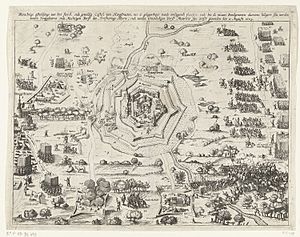Mutiny of Hoogstraten facts for kids
| Date | 1 September 1602 – 18 May 1604 |
|---|---|
| Location | Hoogstraten, Habsburg Netherlands |
| Also known as | the Union of Hoogstraten |
| Cause | arrears of pay |
| Participants | soldiers of the Army of Flanders |
The Mutiny of Hoogstraten was a long protest by soldiers during the Eighty Years' War. This war was a big fight for independence in the Netherlands against Spanish rule. The mutiny lasted from September 1602 to May 1604. It was the longest time soldiers from the Spanish Army of Flanders rebelled.
A leader named Frederick Van den Berg tried to stop the mutiny by attacking the town of Hoogstraten. But his plan failed when an army led by Maurice of Nassau arrived. After almost three years, the rebellious soldiers were allowed to either join Maurice's army or return to the Spanish army with a full pardon.
Contents
Why Soldiers Were Unhappy
The Eighty Years' War was a long and tough conflict. Maurice of Nassau was a Dutch leader who was very good at fighting the Spanish armies. He took advantage of the Spanish Archduke Albert of Austria being busy. Archduke Albert was focused on the difficult Siege of Ostend.
While Albert was busy, Maurice captured several towns that had Spanish soldiers. For example, Maurice successfully took back Rheinberg in July 1601. Then, between July and September 1602, the Dutch and English armies, led by Maurice, captured the town of Grave.
The Hoogstraten Mutiny Begins
| Siege of Hoogstraten | |||||||
|---|---|---|---|---|---|---|---|
| Part of the Eighty Years' War & the Anglo–Spanish War | |||||||
 Relief of the mutineers of Hoogstraten by Maurice's army August 1603 |
|||||||
|
|||||||
| Belligerents | |||||||
|
|
|||||||
| Commanders and leaders | |||||||
| Strength | |||||||
|
14,000 3,000 mutineers |
9,800 | ||||||
After the Spanish lost Grave, the soldiers in the Army of Flanders felt very discouraged. Many soldiers had not been paid for a long time. Also, their food and supplies were very poor. Because of these problems, about 3,000 soldiers decided to rebel. Most of these soldiers were from Italy and Spain.
These unhappy soldiers took over the small town of Hoogstraten. They made it strong so they could defend themselves. From this safe place, the mutineers chose representatives to talk for them. They negotiated with both their own Spanish commanders and with the Dutch government.
The Siege of Hoogstraten
Count Maurice of Nassau hoped to use the mutineers to his advantage. He also understood why they were so frustrated. As Maurice moved his army towards Hoogstraten, he saw another army approaching. This was Frederik van den Berg's army of 10,000 soldiers. Van den Berg had marched from Ostend, gathering more troops. He wanted to take back Hoogstraten and strengthen its defenses.
The two armies faced each other, but neither side wanted to start a big battle. Maurice was looking for a good town where the mutineers could stay safely. On August 3, Maurice entered Hoogstraten. The Spanish mutineers were very happy to see him. They even celebrated his short visit. While there, Maurice signed an agreement. He promised to protect them until they could make peace with Archduke Albert.
Van den Berg realized that Maurice's army was stronger. He also knew that the mutineers were fully on Maurice's side. Van den Berg ordered his army to leave. He was also worried that some of his own soldiers might join the mutineers. Three days later, the Dutch and English advance troops caught up with the back of Van den Berg’s retreating Spanish army.
The mutineers even created their own "state" called the Republic of Hoogstraten. They wore green sashes so everyone could tell them apart from other soldiers. Many mutineers eventually joined the Dutch army. This happened after the Spanish high command declared them outlaws. When Maurice gave them cavalry (soldiers on horseback), they became an even bigger threat. Only then did Archduke Albert agree to a treaty. This treaty gave the mutineers a complete pardon. Spain and its council of state protested this decision, but the Archduke went ahead.
What Happened Next
When winter arrived in 1603, all the armies went to their winter camps. Maurice kept his promise to the mutineers. He gave them the town of Grave to stay in.
The mutiny had a big impact on Spain's military plans. Archduke Albert worried that it might force him to give up the Siege of Ostend. The next year, during the Siege of Sluis, he could not launch any major attacks against Maurice.
An important book about how the mutiny was organized is the autobiography of Charles Alexandre de Croÿ, Marquis d'Havré. He was held by the mutineers for eleven months.

